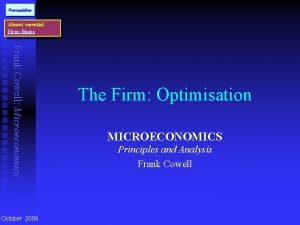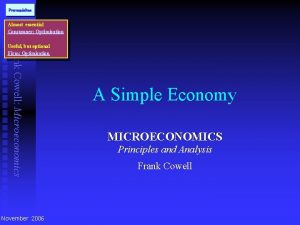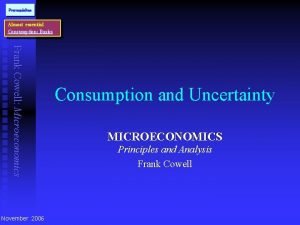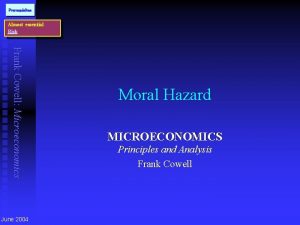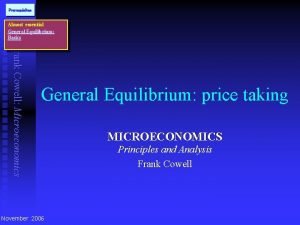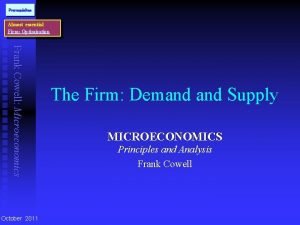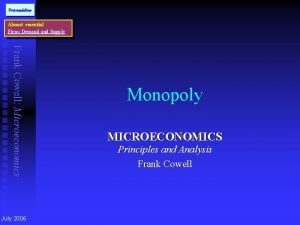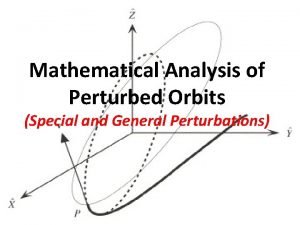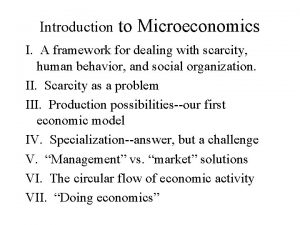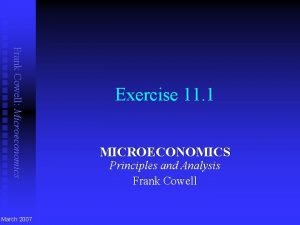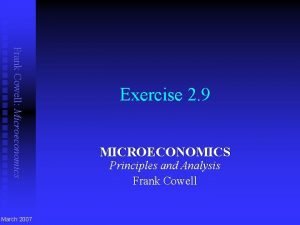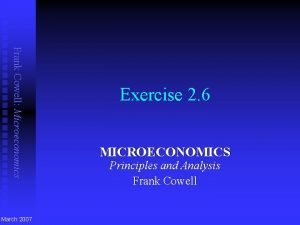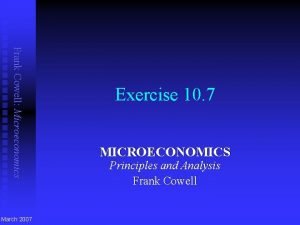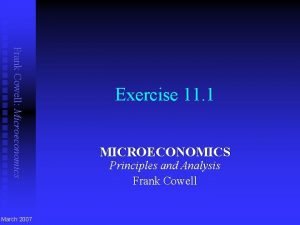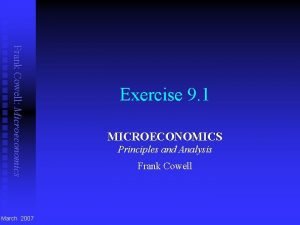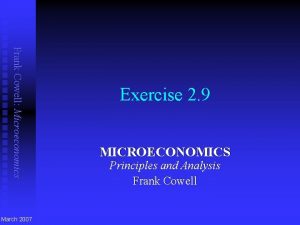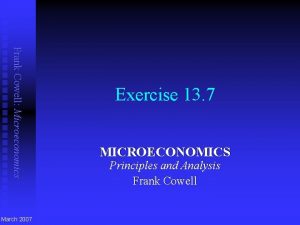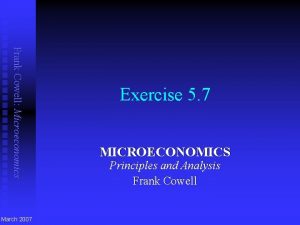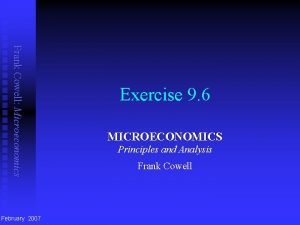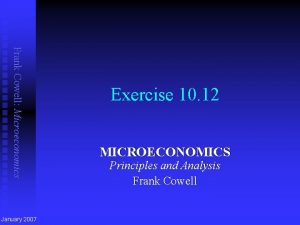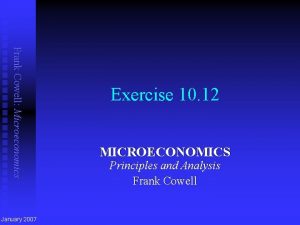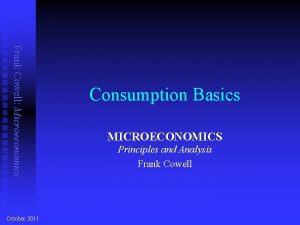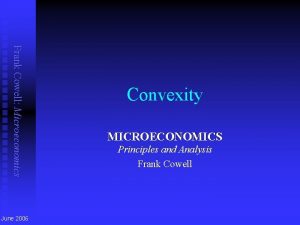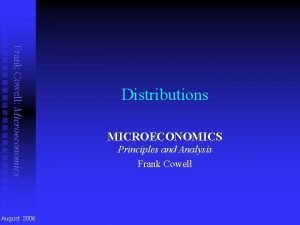Frank Cowell Microeconomics March 2007 Exercise 11 3

















- Slides: 17

Frank Cowell: Microeconomics March 2007 Exercise 11. 3 MICROECONOMICS Principles and Analysis Frank Cowell

Ex 11. 3(1): Question Frank Cowell: Microeconomics n n purpose: solution to an adverse selection problem method: find full-information solution from reservation utility levels. Then introduce incentive-compatibility constraint in order to find second-best solution

Ex 11. 3(1): participation constraint Frank Cowell: Microeconomics n n The principal knows the agent’s type So maximises x y subject to u u n where u = 0 for each individual type In the full-information solution u u the participation constraint binds there is no distortion

Ex 11. 3(1): full-information case Frank Cowell: Microeconomics n Differentiate the binding participation constraint u n n n to find the slope of the IC: Since there is no distortion this slope must equal 1 This implies Using the fact that u = u and substituting into the participation constraint:

Ex 11. 3(1): Full-information contracts Frank Cowell: Microeconomics u _b y §Space of (legal services, payment) §a-type’s reservation utility §b-type’s reservation utility §Contracts • y*a = 1 slope = 1 u _a y*b = ¼ 0 • x*b slope = 1 =½ x*a x =2

Ex 11. 3(1): FI contracts, assessment Frank Cowell: Microeconomics n Solution has MRS = MRT u u n since there is no distortion… …the allocation (x*a, y*a), (x*b, y*b) is efficient We cannot perturb the allocation so as to u u make one person better off… …without making the other worse off

Ex 11. 3 (2): Question Frank Cowell: Microeconomics method: n Derive the incentive-compatibility constraint n Set up Lagrangean n Solve using standard methods n Compare with full-information values of x and y

Ex 11. 3 (2): “wrong” contract? Frank Cowell: Microeconomics n n Now it is impossible to monitor the lawyer’s type Is it still viable to offer the efficient contracts (x*a, y*a) and (x * b , y * b )? Consider situation of a type-a lawyer u if he accepts the contract meant for him he gets utility u but if he were to get a type-b contract he would get utility So a type a would prefer to take… u u a type-b contract rather than the efficient contract

Ex 11. 3 (2): incentive compatibility Frank Cowell: Microeconomics n n Given the uncertainty about lawyer’s type… …the firm wants to maximise expected profits u n n This must take account of the “wrong-contract” problem just mentioned An a-type must be rewarded sufficiently… u n it is risk-neutral so that is not tempted to take a b-type contract The incentive-compatibility constraint for the a types

Ex 11. 3 (2): optimisation problem Frank Cowell: Microeconomics n Let p be the probability that the lawyer is of type a Expected profits are n Structure of problem is as for previous exercises n n u participation constraint for type b will be binding u incentive-compatibility constraint for type a will be binding This enables us to write down the Lagrangean…

Ex 11. 3 (2): Lagrangean Frank Cowell: Microeconomics n The Lagrangean for the firm’s optimisation problem is: u u u n where… l is the Lagrange multiplier for b’s participation constraint m is the Lagrange multiplier fora’s incentive-compatibility constraint Find the optimum by examining the FOCs…

Ex 11. 3 (2): Lagrange multipliers Frank Cowell: Microeconomics n n n Differentiate Lagrangean with respect to xa u and set result to 0 u yields m = pta Differentiate Lagrangean with respect to xb u and set result to 0 u using the value for m this yields l = tb Use these values of the Lagrange multiplier in the remaining FOCs

Ex 11. 3 (2): optimal payment, a-types Frank Cowell: Microeconomics n Differentiate Lagrangean with respect to ya u and set result to 0 n Substitute for m: n Rearranging we find u u u exactly as for the full-information case also MRS = 1, exactly as for the full-information case illustrates the “no distortion at the top” principle

Ex 11. 3 (2): optimal payment, b-types Frank Cowell: Microeconomics n Differentiate Lagrangean with respect to yb u and set result to 0 n Substitute for l and m: n Rearranging we find u u this is less than ¼[tb ]2 … …the full-information income for a b-type

Ex 11. 3 (2): optimal x Frank Cowell: Microeconomics n Differentiate Lagrangean with respect to l u and set result to 0 get the b-type’s binding participation constraint this yields u which becomes u u n Differentiate Lagrangean with respect to m u u u n and set result to 0 get the a-type’s binding incentive-compatibility constraint this yields These are less than values for full-information contracts u for both a-types and b-types

Ex 11. 3 (2): second-best solution Frank Cowell: Microeconomics §a-type’s reservation utility §b-type’s reservation utility §a-type’s full-info contract §b-type’s second-best contract §a-type’s second-best contract u _b y ^ya • • u _a ^yb 0 • ^xb ^xa x

Ex 11. 3: points to remember Frank Cowell: Microeconomics n n Standard “adverse-selection” results Full-information solution is fully exploitative u n Asymmetric information u n binding participation constraint for both types incentive-compatibility problem for a-types Second best solution u u u binding participation constraint for b-type binding incentive-compatibility constraint for a- type no distortion at the top
 Cowell microeconomics
Cowell microeconomics Almost essential
Almost essential Cowell microeconomics
Cowell microeconomics Cowell microeconomics
Cowell microeconomics Cowell microeconomics
Cowell microeconomics Cowell microeconomics
Cowell microeconomics Cowell microeconomics
Cowell microeconomics Cowell microeconomics
Cowell microeconomics Frank cowell
Frank cowell Frank cowell
Frank cowell Anthem of poland
Anthem of poland Kevin cowell
Kevin cowell Anna cowell
Anna cowell Encke's method
Encke's method Cowell e holdings
Cowell e holdings Frank william abagnale jr wife
Frank william abagnale jr wife Microeconomics ia
Microeconomics ia Micro macro economics
Micro macro economics
